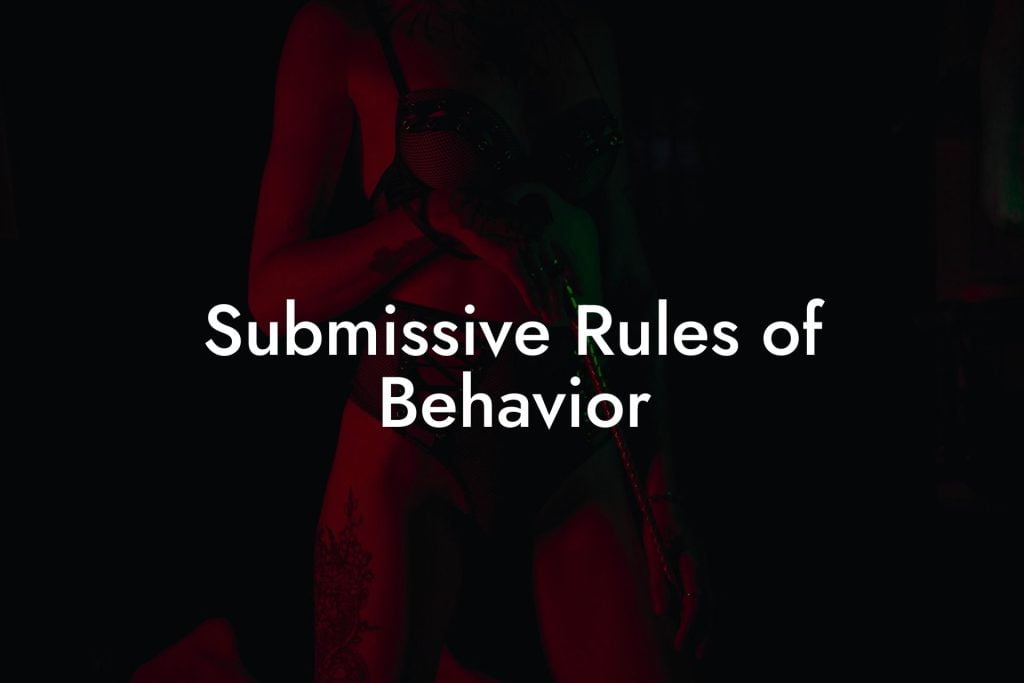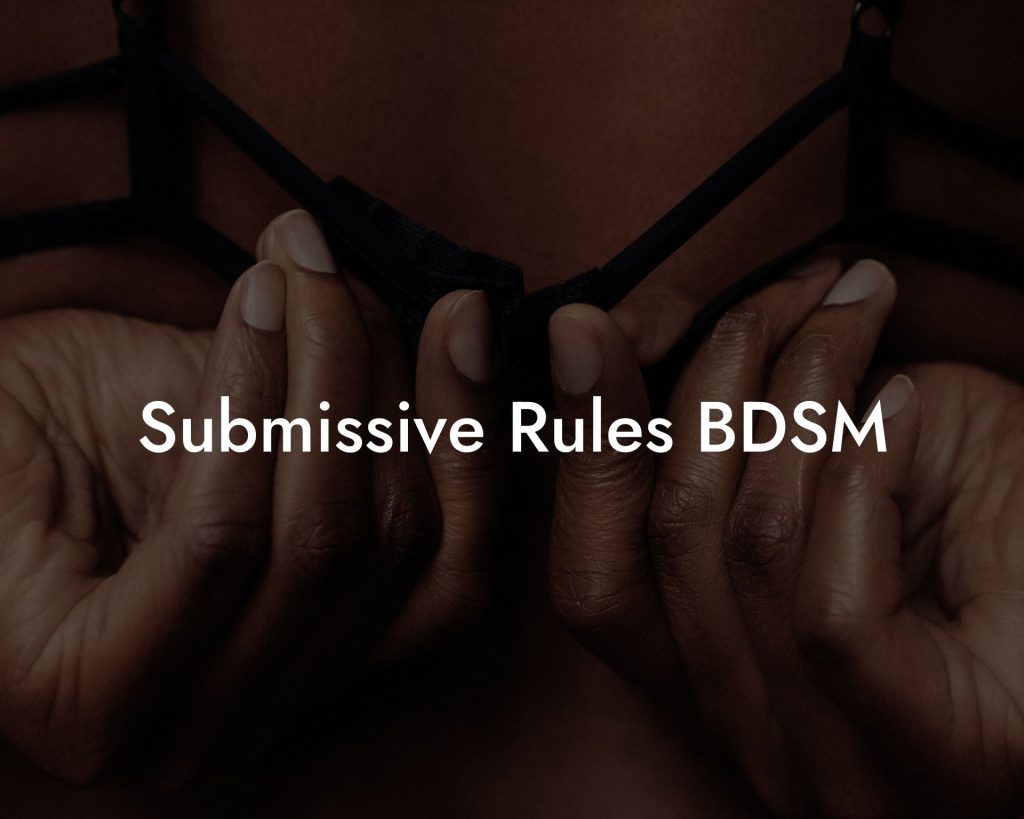In the world of BDSM, the dynamics between dominant and submissive partners are built on trust, communication, and mutual understanding. One significant aspect of a BDSM relationship is the creation of a contract that outlines the parameters, boundaries, and expectations agreed upon by both parties. In this article, we will delve into the essentials of a submissive's contract, emphasizing the importance of consent, communication, and setting healthy boundaries.
In any BDSM relationship, consent is the cornerstone of trust and respect. It’s more than just saying “yes” or “no”—it’s about openly communicating your desires, limits, and expectations. But trust doesn’t end with a conversation—it’s built through ongoing, clear agreements. That’s where our Dominant & Submissive BDSM Contract Pack comes in. Find out more →
Consent as the Cornerstone
Before exploring the specifics of a submissive's contract, it is crucial to highlight the essence of consent in BDSM relationships. Consent must be enthusiastic, informed, and ongoing. Both partners must willingly agree to participate in any activities described in the contract, and clearly communicate their limits and desires. It is essential to establish a safe word or signal that can be used to pause or stop any activity if needed.
Key Elements of a Submissive's Contract
Roles and Responsibilities
This section outlines the roles and responsibilities of both the submissive and the dominant partner in the relationship. It clarifies the expectations and tasks each party must fulfill, emphasizing how power dynamics will be established and maintained.
Limits and Boundaries
Setting clear boundaries is paramount in BDSM relationships to ensure the physical and emotional well-being of all participants. This section defines the hard limits (activities that are absolutely off-limits) and soft limits (activities that may be explored gradually or with specific conditions) of the submissive. It also allows room for negotiation and revisiting boundaries as the relationship evolves.
Communication and Safety
Effective communication is the backbone of any healthy BDSM relationship. This section highlights the importance of regular check-ins, active listening, and constant dialogue between partners. It also outlines protocols for handling concerns, conflicts, and aftercare procedures to ensure emotional and physical safety at all times.
Looking for the best BDSM & Kink OnlyFans content creators? Here is a list of of our favourites that you will love:
-
- Best BDSM & Fetish OnlyFans - Molly✨ >> Link
- Best BBW & Huge Ass OnlyFans - Naughty Hanna Zimmer 💜🎀 >> Link
- Best Sexy Gaming Nerd OnlyFans - 🎮 Gracy EstuSWEET 🎮 >> Link
- Best Fetish & Kink Messaging OnlyFans - 💫Lola La Fleur 💫 >> Link
- Best Girl Next Door OnlyFans - ☀️Lily ⛅ >> Link
- Best Tiny European OnlyFans - 💝 Ami Allison 💝 >> Link
- Best Cosplay OnlyFans - 🐱 Little Kitty Kate 👉👌 >> Link
- Best Little OnlyFans - 🧸 Katya 🙇♀️ Sun >> Link
- Best Sub OnlyFans - 🍌Hanna Banana🍌 >> Link
- Best Teen & Huge Tits OnlyFans - ❣️Anny❣️19 y.o. BUSTY student girl >> Link
- Best Tiny Tits OnlyFans - ⍣⭐️ Sofia Parker ⭐️⍣ >> Link
- Best Sub & Huge Boobs OnlyFans - Nika Huge Boobs >> Link
- Best Kink OnlyFans - Sofia💖 >> Link
- Best Fetish & Girl Next Door OnlyFans - Hillary is Wet 💦 >> Link
- Best Dirty Latina OnlyFans - Paula Flores 😈 >> Link
Not quite what you are looking for? View the full list →
Duration and Termination
This section establishes the timeframe of the contract. Whether it is a short-term arrangement or a long-term commitment, both parties need to agree on the duration. Additionally, it should lay out the process for terminating the contract if either partner feels the need to end the relationship.
Frequently Asked Questions
What is a BDSM contract?
A BDSM contract is a written agreement between the participants in a BDSM activity or relationship. It outlines the roles, responsibilities, limits, and expectations of everyone involved. It is used to establish a clear communication channel and to provide a framework for consent and boundaries.
Is a BDSM contract legally binding?
No, in most places BDSM contracts are not legally binding. They are more symbolic and serve as a tool for communication and negotiation between the parties involved. The ethical and emotional commitment by the signatories, however, is significant in the BDSM community.
Why are power dynamics important in BDSM?
Power dynamics are central to BDSM activities. They refer to the power exchange between the dominant and submissive participants. This exchange is consensual and can create a deeper level of trust and intimacy when done correctly.
Does BDSM always involve physical pain or discomfort?
No, BDSM doesn't necessarily involve physical pain or discomfort. It encompasses a wide range of activities and power dynamics, some of which may include sensations such as impact play or restraint, while others focus on emotional dominance and submission.
How do you negotiate a BDSM scene or relationship?
Negotiation in BDSM involves discussing the desires, limits, and expectations of each participant. It's crucial to talk about safe words, health considerations, and aftercare needs. Open communication before, during, and after the scene or relationship is essential for mutual satisfaction and safety.
What is a safe word?
A safe word is a pre-agreed word or signal that participants in BDSM use to immediately halt the activity. It is a safety mechanism to ensure all actions cease if someone is uncomfortable, in pain, or needs to stop for any reason.
Can someone change their mind after giving consent?
Yes, consent in BDSM is reversible and ongoing. A participant can withdraw consent at any point if they feel uncomfortable or if the activity isn't what they expected.
Why is trust important in a BDSM relationship?
Trust is paramount in BDSM because of the vulnerable and exposed positions participants might find themselves in. Safe, sane, and consensual activities depend on a mutual trust that partners will respect boundaries and adhere to the terms of the contract.
What is aftercare and why is it important?
Aftercare refers to the care and attention given to participants after a BDSM scene or activity. It can involve physical care, like tending to any marks or providing comfort, as well as emotional support to ensure all parties feel safe and respected. Aftercare helps in grounding the participants and processing the experience.
How do you establish limits in a BDSM arrangement?
Limits in BDSM are established through open and honest communication. Participants should discuss what they are and aren’t comfortable with, including any hard limits (non-negotiables) and soft limits (activities that may require caution or gradual exploration).
What are some red flags to watch out for in BDSM?
Red flags in BDSM include a partner who doesn’t respect your boundaries or limits, pressures you to move too quickly, ignores safe words, or doesn’t engage in aftercare. A lack of communication and transparency is also a significant concern.
Can BDSM activities be corrective or therapeutic?
Some people find BDSM activities to have therapeutic aspects, such as release of control or catharsis from physical play. However, BDSM is not a replacement for professional therapy if someone is dealing with deep-seated psychological issues or trauma.
How should a beginner approach BDSM?
Beginners should approach BDSM by educating themselves about safe practices, clear communication, and consent. They should start slow, experiment with less intense activities, and constantly communicate with their partner about comfort levels and interests.
Do I need expensive equipment to practice BDSM?
No, you do not need expensive equipment to practice BDSM. Many BDSM activities can be explored with minimal or improvised gear. Creativity and communication can compensate for the absence of professional equipment.
Is there a difference between a scene and a relationship in BDSM?
Yes, a 'scene' typically refers to a single BDSM activity or encounter, while a 'relationship' suggests a more sustained power dynamic and interaction between participants. Both still require consent and communication.
Can BDSM be practiced without a sexual component?
Yes, BDSM can certainly be practiced without a sexual component. Some participants enjoy the dynamics of power exchange, sensation play, or the psychological aspects without involving sexual activity.
What does it mean to be “vanilla”?
'Vanilla' is a term often used to describe someone who prefers not to engage in BDSM activities or who has conventional sexual preferences. It's important not to use the term in a derogatory manner, as all sexual preferences are valid.
Are all BDSM practitioners in a dominant or submissive role?
While many people in the BDSM community identify as either dominant or submissive, there are other roles and dynamics as well, including 'switches' who may alternate between roles. Non-traditional roles and dynamics are equally valid and recognized in BDSM.
How can I ensure my BDSM activities are ethical?
To ensure BDSM activities are ethical, all parties should give informed, enthusiastic, and ongoing consent. Respect for limits, adherence to safety protocols, and engaging in aftercare are important elements of ethical BDSM practices.
Is it normal to feel unsure or guilty about being interested in BDSM?
It is not uncommon to feel unsure or guilty due to societal stigmas around BDSM. However, interest in BDSM is quite normal and can be a healthy part of your sexuality as long as it is practiced safely and consensually. Seeking community support and education can help alleviate these feelings.
As you can see, a submissive's contract forms the foundation of a healthy and consensual BDSM relationship. It ensures both partners are on the same page, respecting each other's limits, desires, and boundaries. If you're intrigued by the world of BDSM and want to explore further, Filthy Adult is your go-to resource. Check out our Ultimate BDSM Contract Pack, read other informative guides on Filthy Adult, and don't forget to explore our fetish shop for a wide range of arousing products.













